

(7) Here's what happens to your knuckles when you crack them. (7) How Does a Bone Heal? How Bones Break. How Do Bones Break?
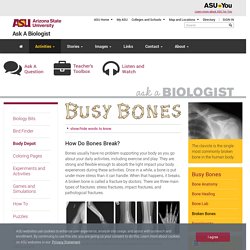
Bones usually have no problem supporting your body as you go about your daily activities, including exercise and play. They are strong and flexible enough to absorb the light impact your body experiences during these activities. Once in a while, a bone is put under more stress than it can handle. When that happens, it breaks. A broken bone is called a fracture by doctors. Bones can break for different reasons and in different ways. Bone Stress Over Time Stress fractures happen when too much pressure is placed on the same spot on a bone over long periods of time. A common stress fracture happens in the legs and feet of runners and athletes. Impact Fractures Sudden impact fractures happen when a bone takes a sudden, hard hit that puts more stress on it than it can handle at once.
Bone Structure. THE SKELETON. Shape and support.
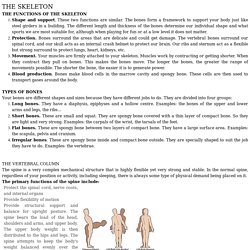
These two functions are similar. The bones form a framework to support your body just like steel girders in a building. The different length and thickness of the bones determine our individual shape and what sports we are most suitable for, although when playing for fun or at a low level it does not matter. Protection. Bones surround the areas that are delicate and could get damage.
Your bones are different shapes and sizes because they have different jobs to do. Types of Bones. The Human Skeletal System. The human skeletal system is not quite as simple as the popular children's song suggests.
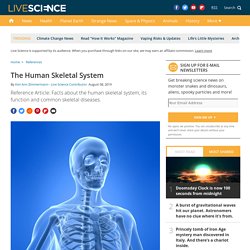
Introduction to the Skeletal System. 6.1 The Functions of the Skeletal System – Anatomy and Physiology. Learning Objectives By the end of this section, you will be able to: Define bone, cartilage, and the skeletal systemList and describe the functions of the skeletal system Bone, or osseous tissue, is a hard, dense connective tissue that forms most of the adult skeleton, the support structure of the body.
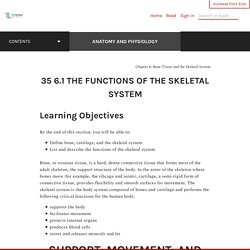
In the areas of the skeleton where bones move (for example, the ribcage and joints), cartilage, a semi-rigid form of connective tissue, provides flexibility and smooth surfaces for movement. Parts, Functions, Diagram, & Facts. Human skeleton, the internal skeleton that serves as a framework for the body.

This framework consists of many individual bones and cartilages. There also are bands of fibrous connective tissue—the ligaments and the tendons—in intimate relationship with the parts of the skeleton. This article is concerned primarily with the gross structure and the function of the skeleton of the normal human adult. The human skeleton, like that of other vertebrates, consists of two principal subdivisions, each with origins distinct from the others and each presenting certain individual features. These are (1) the axial, comprising the vertebral column—the spine—and much of the skull, and (2) the appendicular, to which the pelvic (hip) and pectoral (shoulder) girdles and the bones and cartilages of the limbs belong. Get exclusive access to content from our 1768 First Edition with your subscription. A distinctive characteristic of humans as compared with other mammals is erect posture.
Osteoporosis Prevention: Healthy Bones Matter at All Ages - United Dairy Industry of Michigan. Do you know if you’re at risk for osteoporosis or how to build and maintain strong bones for life?
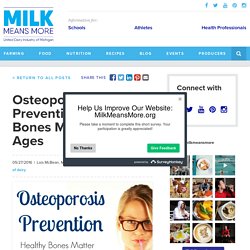
To raise awareness of osteoporosis, the National Osteoporosis Foundation has designated May as National Osteoporosis Month. This year’s theme, “Break Free from Osteoporosis,” encourages people to discover their risk factors and make lifestyle choices that promote maximal bone health throughout life. What You Need to Know about Osteoporosis. Do you know that as many as 50% of women and up to 25% of men over age 50 will break a bone due to osteoporosis? It is a silent disease characterized by low bone mass and increased risk of bone fractures. A variety of risk factors, both genetic and environmental, determine whether a person will develop osteoporosis and be susceptible to fractures. Preventing Osteoporosis throughout Life. You’re never too young or too old to improve your bone health.
Milk Means More for Bone Health.